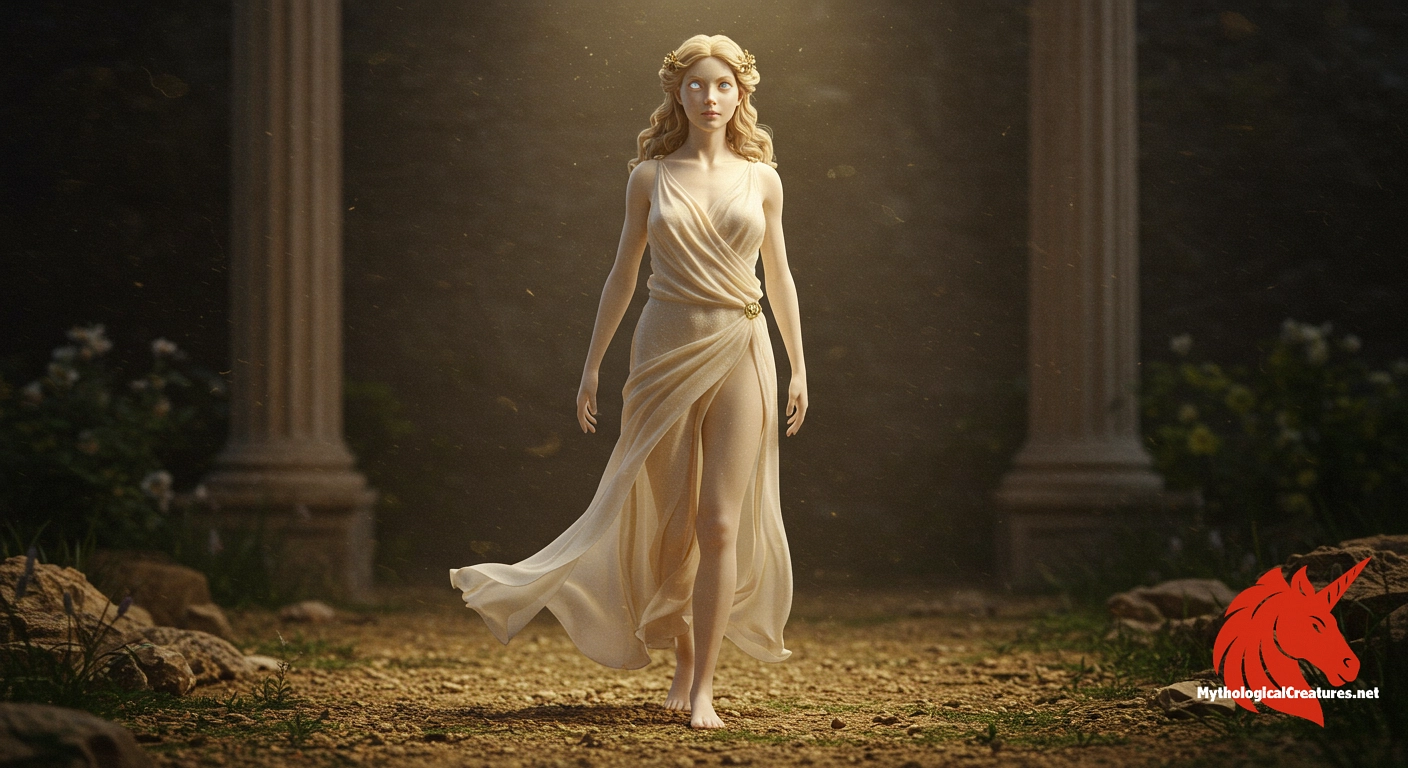Eileithyia: Eileithyia is the ancient Greek goddess of childbirth and midwifery.

Eileithyia
Eileithyia - Eileithyia is pivotal in ancient Greek mythology for her role in facilitating childbirth and ensuring the continuation of life.
Origins & First Encounters
Eileithyia stands as a revered figure in Greek mythology, celebrated as the goddess of childbirth and midwifery. Born of Zeus and Hera, she occupies a unique place among the divine, embodying the mystery and hope inherent in the process of birth. Her origins are deeply entwined with early Greek religious practice, where rituals and celebrations marked the miracle of new life. In ancient Crete, she was honoured within sacred caves such as Amnisos, a setting that underscored the elemental and chthonic nature of her cult. The goddess’s presence is felt not only in myth but also in the practical lives of ancient Greeks, who looked to her for protection during the vulnerable moments of childbirth. Her early attestations hint at a synthesis of older, pre-Hellenic fertility traditions with the structured pantheon of Olympian gods. Eileithyia’s role bridges the celestial and the earthly, making her a mediator between the divine realm and mortal struggles. She was often depicted as a comforting figure, one whose intervention could ease labour pains and secure the safe arrival of the newborn. The enduring appeal of her character lies in her dual power to both nurture life and regulate its delicate passage into the world. Ultimately, her myth encapsulates the ancient Greeks’ profound reverence for the forces that govern regeneration and the cyclical nature of existence.
Source Texts & Tale Variants
Ancient literature and inscriptions offer a multifaceted view of Eileithyia, with some texts vividly capturing her role in birth and others hinting at deeper, esoteric rituals. Pindar’s Seventh Nemean Ode, for example, places her in the unusual company of the Moirai, highlighting her responsibility for the creation of offspring. Variants of her name appear in different regions, with forms such as Eleuthyia and Eleuthia attesting to local traditions that shaped her mythos. Various fragments of lost hymns, along with vase-paintings and cultic artefacts, suggest that her worship was widespread and adapted to regional needs. Some narratives recount her assistance in the labours of goddesses and mortal midwives alike, underscoring her universal appeal in matters of birth. Other ancient sources hint at a possible connection with the mysteries of Eleusis, pointing to an overlap between fertility rites and secretive initiation ceremonies. There is evidence that her iconography was adapted over time to incorporate elements of local hero cults and chthonic deities. Even when explicit textual descriptions are scarce, the recurring themes in ancient religious practice illuminate her central role in the mythological framework. These diverse sources provide a rich tapestry of interpretations, offering scholars a complex picture of a goddess who was both a nurturer and a guardian of life’s critical transitions. Each variant in the ancient record contributes to our modern understanding of how the divine was interwoven with everyday human experience.
Form & Powers
Descriptions of Eileithyia often focus on her ethereal and nurturing appearance, although specific physical details vary from one artistic representation to another. In many traditions, she is depicted as youthful and serene, symbolising the promise of new beginnings and the purity of life. Artists commonly portrayed her with gentle features and a calm, reassuring gaze that mirrored the tender aspects of childbirth. She is sometimes shown adorned in flowing robes that evoke the natural cycles of birth and rebirth, hinting at an almost arboreal connection to nature. Occasionally, iconography includes symbols such as a torch or a lamp, representing the illumination of life’s path during dark times. The goddess’s attire might also feature subtle references to the phases of the moon, reinforcing her association with cycles of renewal. Some vase paintings suggest that Eileithyia was portrayed with hands outstretched, as if offering aid or blessing to those in need. Her form, though not rigidly standardised, radiates a sense of gentle authority and grace which reassured devotees during the turbulent moments of labour. Variations in her depiction may reflect regional preferences or evolving artistic styles, yet the central theme remains consistent: a divine figure intimately connected with the miracle of childbirth. This blend of human warmth and divine power continues to captivate those who delve into the visual traditions of ancient Greece.
Regional Faces
The worship of Eileithyia demonstrated notable regional diversity, reflecting the varied cultural landscapes of ancient Greece. In Crete, where her cult is strongly attested, she was revered as a primal figure associated with the natural and subterranean realms, often celebrated in cave sanctuaries. By contrast, in Laconia and Messene, local variations of her name—such as Eleuthia and Elysia—hint at adaptations tailored to specific community needs and local mythological frameworks. The rituals celebrated in these regions tended to merge her function as a midwife with broader fertility rites that honored the cyclical rhythms of nature. In some areas, her iconography was interlaced with that of other deities, suggesting an ongoing process of religious syncretism. Certain local traditions even linked her with chthonic forces, as seen in associations with deities like Poseidon in his earth-shaking aspect. This layering of myth in different geographical locales underscored the adaptability of her character to regional narratives and the daily realities of the people. Localised festivals and rites dedicated to her celebrated the renewal of life, knitting together the physical and spiritual practices of the community. Over time, these regional variations enriched the overall tapestry of her mythology, allowing her to be seen as both a universal and locally nuanced deity. The interplay between her widespread cult and regional specificities accentuates the complexity and depth of her enduring legacy.
Cultural Parallels
The role of Eileithyia in Greek mythology finds interesting parallels in various other cultural traditions, where the divine aspects of childbirth and fertility are similarly celebrated. In Roman mythology, for instance, the goddess Lucina functions in a comparable capacity as a guardian of childbirth, reflecting analogous traits of care and protection. European pagan traditions also revered local deities with overlapping domains, often linking the process of birth to cycles of nature and seasonal change. In the Near East, goddesses like Ishtar exhibited attributes related to fertility and life-giving power, demonstrating remarkable cross-cultural echoes. Though the narratives and iconographies differ, the underlying impetus of invoking divine favour during childbirth is a shared theme. The universality of the birth process has led many cultures to invest symbolic and ritual power in deities who oversee this crucial aspect of life. Eileithyia’s integration with the fates and elements of nature mirrors a broader mythological motif that spans continents and ages. These cultural intersections highlight how ancient societies sought to understand and manage the generative forces of nature through divine personifications. By comparing her with counterparts in other myth systems, one gains insight into both the distinctive qualities of Greek tradition and the common human desire to secure safe passage through the vulnerable moments of life. Ultimately, such comparative analysis enriches our appreciation of how various cultures have embraced the sacred power of reproduction and renewal.
Legacy & Modern Evolution
The evolution of Eileithyia’s depictions over the centuries reflects an enduring transformation that parallels broader shifts in religious thought and artistic expression. During antiquity, she was celebrated in vibrant religious rites and depicted in sculpture, vase painting, and literature that underscored her nurturing power. Over time, classical representations softened as changes in societal structures and medical practices began to alter perceptions of childbirth. In later periods, particularly during the Renaissance, classical imagery was reinterpreted through the lens of humanist ideals and artistic revival, which brought renewed attention to the symbolic aspects of her character. Modern scholarship has revisited her myth, often highlighting the intersection between gender, fertility, and divine intervention in ancient Greek society. Contemporary interpretations have seen her as both a historical deity of practical relevance and a metaphor for the continual cycle of life and renewal. Her influence is also evident in modern literature and popular culture, where themes of rebirth and transformation frequently echo the ancient myths. The goddess’s legacy persists not only in academic studies but also in cultural expressions that celebrate the miraculous nature of childbirth. Moreover, discussions around her myth continue to inspire debates about the roles of women and the deification of natural processes. In this way, Eileithyia retains a lasting relevance, bridging ancient tradition with modern sensibilities and symbolising an eternal aspect of human experience.
Interesting Fact
An interesting observation is that Eileithyia's cult practices not only emphasise the significance of childbirth in ancient Greek culture but also reveal intricate connections between various divine entities and the natural cycle of life.
Quick Creature Info
Origin:
Features:
Our Mythic Legendary Rating:

Also Sometimes Known As:
Habitat:
Supernatural Powers:
Physical Attributes:
Abilities:
Behavior:
Lore:
Related Creatures, Tales or Lore
- LLucina (Roman goddess of childbirth)
- AArtemis (Greek goddess associated with childbirth)
References
Discover Another Mythical Legend You May Not Have Heard Of?
Uncover the mysteries of ancient folklore and expand your knowledge of legendary beings from cultures around the world.
Dare to Meet the Cydippe....
Mythical Disclaimer: The images and data on this site are derived from various historical and literary sources, but we have found that many myths often have multiple versions and interpretations across references, sometimes contradictory. As a result, these creature depictions are artistic interpretations—imaginative blends of folklore, legend, and a dash of AI guesswork. Because creature descriptions vary widely, our illustrations and accompanying information represent our best effort to honor mythology while bridging creative gaps. Enjoy these interpretations—just remember, we've done our best to respect the stories and validate available data, but in the realm of mythology, details often shift, imagination leads the way, and nothing is ever set in stone!
Curated by the Mythological Creatures Team (rev. May 2025)
